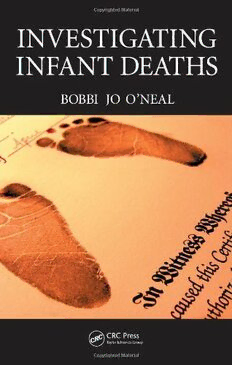
Investigating Infant Deaths PDF
252 Pages·2007·5.63 MB·English
Most books are stored in the elastic cloud where traffic is expensive. For this reason, we have a limit on daily download.
Preview Investigating Infant Deaths
Description:
It stands to reason that the most difficult cases to investigate are those in which the individual’s death was sudden, unexpected, and unexplained. Very few deaths occur where the deceased has no significant medical history, no trauma, no significant autopsy findings, and very little social history in which to investigate. Infant deaths almost always fit this category, making them consistently the most complicated and challenging deaths to investigate. Investigating Infant Deaths draws on the expertise of a forensic nurse and member of the CDC core team for the Sudden Unexpected Infant Death Investigation Reporting Form to provide medicolegal death investigators and law enforcement personnel with investigative techniques applicable to sudden unexpected infant deaths. Beginning with a general state-of-the-field, the author defines the role of the investigator and explains the benefits of “double-teaming” an investigation. The book emphasizes the importance of timing and gives crucial tips for examining the incident scene and performing an initial post-mortem external exam. Specific instruction regarding the “art” of interviewing the grieving parents and how to follow up with families gives investigators an important edge when autopsy findings are slim. Additional chapters cover how to use a doll re-enactment and how to review medical records, social service records, and criminal histories. It also illustrates how to set up task forces including State Child Fatality Teams and an Investigative Child Death Review at the local level. Case studies are used throughout the book to give investigators real-life examples of the techniques at work. Presenting a workable approach that may facilitate a re-evaluation of current protocols, Investigating Infant Deaths provides the tools for continued improvement that will ensure all infant deaths are investigated thoroughly and thereby help prevent future premature infant deaths from occurring.
See more
The list of books you might like
Most books are stored in the elastic cloud where traffic is expensive. For this reason, we have a limit on daily download.
